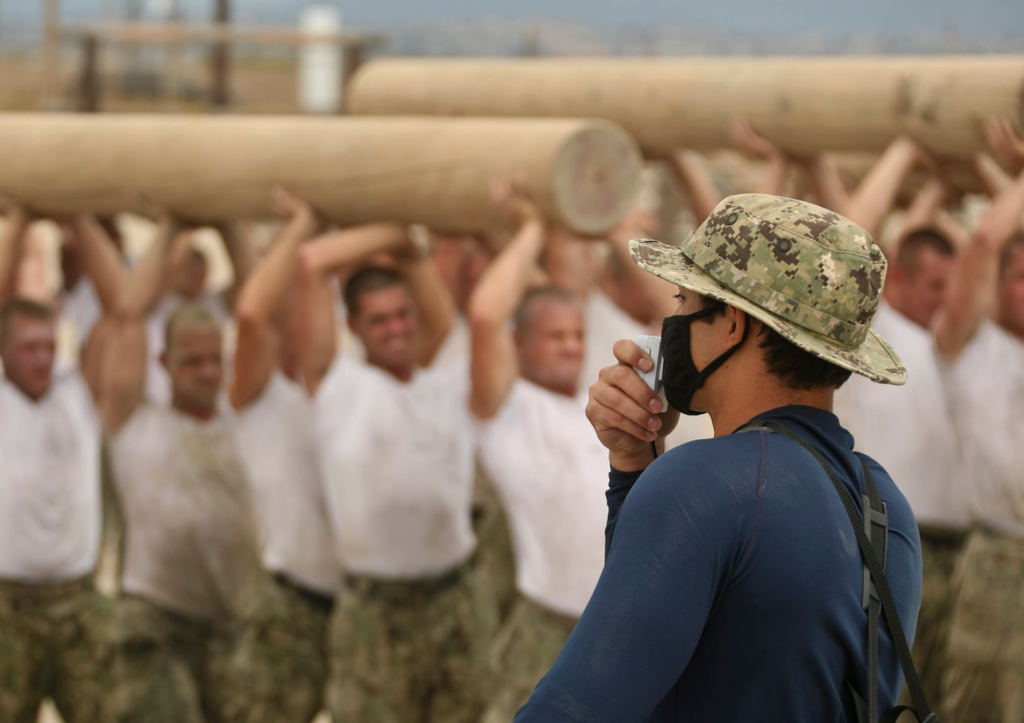
“Hooyah!” and other screams of motivation pierced the crisp Coronado, California, air in the early hours of May Naval Special Warfare Center. The compound’s normally serene night was now a raucous scene, as nearly 180 Navy SEAL candidates rushed to their set of Frogman flippers checkered in white paint across the field of blacktop that is the dreaded BUD/S 1st Phase Grinder.
Instructors shouting through megaphones, a light rain falling from hoses and good, old-fashioned adrenaline fueled prospective special operators through the traditional predawn physical training session that signifies the start of Basic Underwater Demolition/SEAL training, or BUD/S.
Class 342’s induction marked the resumption of training for three classes put on pause March 16 due to COVID-19.
“We took a conservative approach to properly assess our student population and establish protocols in order to minimize risk to them during training,” said Navy Capt. Bart Randall, the commodore of the Naval Special Warfare Center.
The decision to restart BUD/S 1st and 2nd Phases, and Special Warfare Combatant-craft Crewman Basic Crewman Selection was based on mitigation efforts put in place that follow Centers for Disease Control and Prevention recommendations and Defense Department medical professional guidance, Randall said.
Instructors now wear face masks and gloves, when necessary, and classes are seeing an increased emphasis on practicing social distancing to the greatest extent possible. This includes limiting the number of students in a classroom and putting methods in place during group training events such as class runs and swims, to ensure adequate physical separation.
Also critical to mitigating the spread of COVID-19 is keeping SEAL and SWCC students in a “closed ecosystem,” Randall said.
This starts for most students when candidates enter the Navy at Recruit Training Command, where they are quarantined for two weeks prior to starting boot camp. The protective bubble carries over to Naval Special Warfare Prep, where students transit to another part of Naval Station Great Lakes, Illinois, for the two-month training phase. Those who qualify for the orientation phase in Coronado are then flown on military aircraft to a military base to protect students from outside exposure.
“I want our students, instructors and staff to have the safest environment possible,” Randall said. As students continue through their respective pipelines at Naval Special Warfare Center, so do the mitigation policies. Classes perform daily COVID-19 screenings; get to-go meals from the base galley, eating only with their classmates; and sanitize their water bottles daily.
And how do these mitigation efforts affect NSW’s exceptionally high standards? “We are not going to change the training we have established throughout the history of NSW,” Randall said.
There is “total buy-in” on the importance of COVID-19 mitigation efforts from leadership down to the instructors standing on the berm, he said. “The instructors are a few steps back now, they can stand off 10 feet, and the students have no problem hearing them.”
Training cadre members also understand the importance of maintaining standards.
“They know they are here to create their future teammates,” Randall said. “Our instructors will rotate from here right back to a SEAL platoon, and these young operators will be next to them in formation, downrange, defending our way of life.”
Not compromising NSW Center’s high-caliber of training requires balancing the risk to the mission with the risk to the force.
The nature of many SEAL and SWCC training evolutions means students are going to be close to each other, Randall said. Physical proximity not only is needed for students to complete events, but also is essential in developing tight bonds among classmates, he explained.
“The relationships developed are like that of a family member,” he said. “They help you get to graduation and are later critical to the success of a SEAL or Special Boat Team.”
Still, the health, safety and welfare of everyone involved in the training process is paramount, Randall emphasized.
“If any student shows signs of illness, we will pull them from training to be evaluated by medical professionals,” Randall said. “We will take care of them and make sure they are healthy before getting them back in the fight.”
Printed with permission of US Department of Defense
Written By: Navy Lt. John Mike
(Navy Lt. John Mike is assigned to the Naval Special Warfare Center.)




